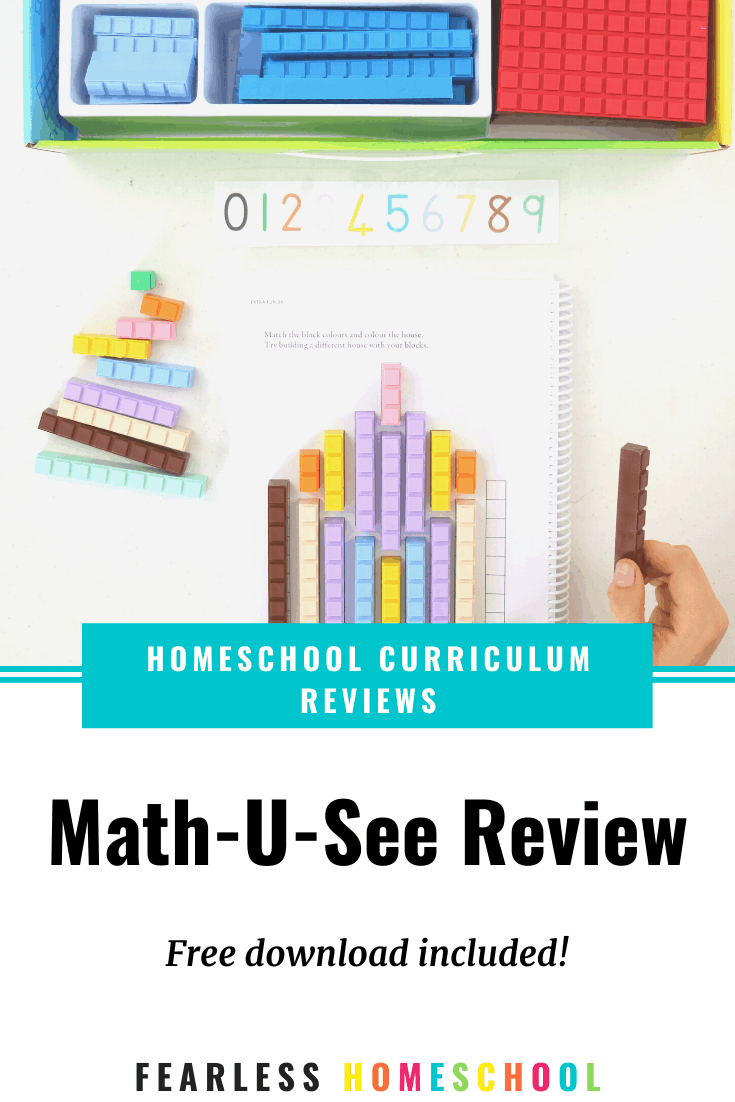
Maths is important.
And like most things, as I learn more about it I realise that it’s far more important than I originally thought.
A lot of parents say to me, “Oh, my kids will just pick it up, as long as they can get through everyday life I don’t mind if they know all that extra stuff, we don’t need it, I get by just fine.” But most people don’t just pick it up intuitively, not past the basics. And I think a lot of the time it’s a case of not knowing what we don’t know, and not realizing just what we’re missing out on by not knowing…

A perfect example that I didn’t grasp until I was an adult is compounding interest, which is like financial magic. Most people don’t understand how compounding interest works, and as a result neglect to invest for the long-term and instead get stuck in consumer debt.
If I’d know that investing $10,000 at 20 and then forgetting about it for 50 years would give me over half a million dollars in retirement, I’d have done it then. Yes, the lighter blue is all interest. Free money!
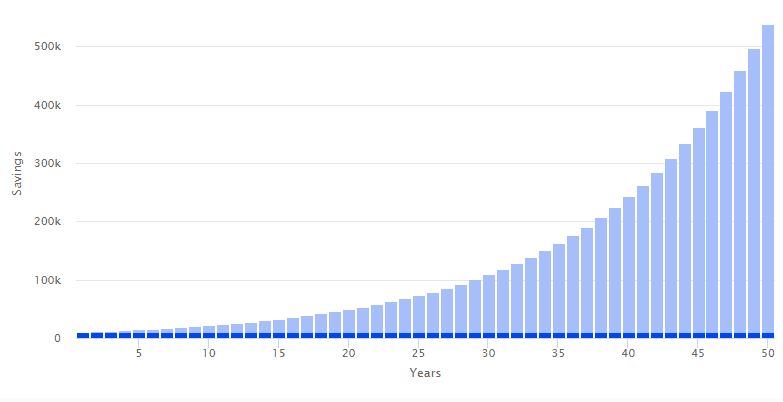
On the other hand, if you DON’T understand how maths and compound interest works you get taken advantage of. And spend 44 years paying back $36 332 on a $10 000 debt. Eek!
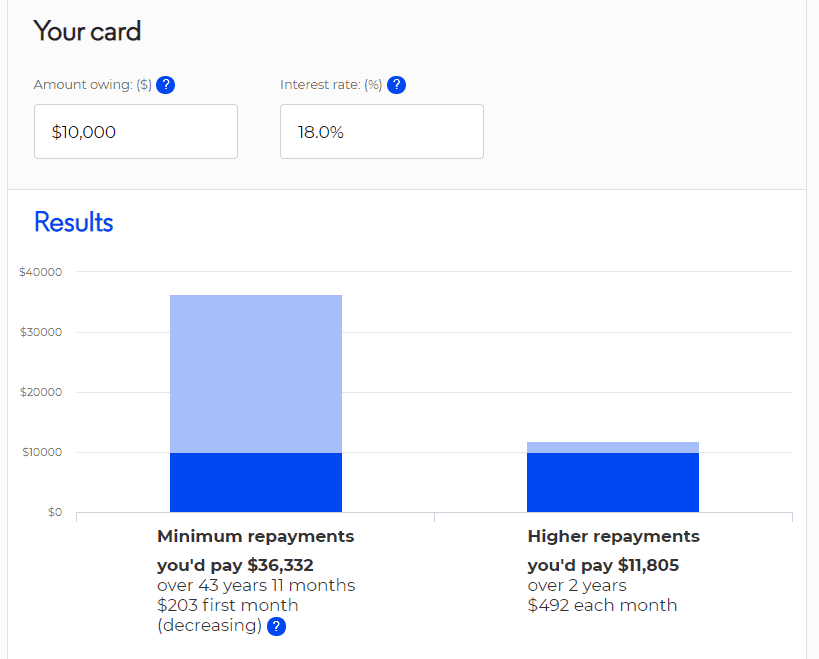
Anyway, I always wanted to give my kids a good grounding in maths, to make sure that they could work out every problem that came their way and make educated decisions, financially and otherwise. But when we started homeschooling there weren’t a lot of Australian maths curriculum options.
So we started off with workbooks. We’d get whatever looked interesting at the time at their level, and work through it. I didn’t get the teacher guides because they were geared for classrooms, with lots of time-filler activities. And this served us fairly well for a while, but over the last few years I’ve been dissatisfied with workbooks for a few reasons.
Firstly, they don’t teach deeply. There was so little practice of each concept before forging ahead to the next topic. We partly combatted this by doing multiple workbooks and supplementing with hands-on activities (because that’s what homeschoolers do, right? Monopoly definitely counts as maths time!)
Secondly, I found my kids having difficulty applying what they’d learned in everyday life. And this is the most important part! It’s no good having calculators in our pockets if we don’t know which sums to type in.
And thirdly, once they reached high school the textbooks were pretty ordinary. We struggled to find books that included clear explanations, and we didn’t like the online programs we tried.
We definitely needed a change. After working with Maths Australia for the 2019 Australian Homeschooling Summit I was intrigued by the method, and they offered to send me a great big box of their maths curriculum. Perks of blogging!

So full disclosure, I got all my stuff for free – but you guys know that if I didn’t like it, I’d just send it back again. All opinions and experiences are mine and aren’t influenced by Maths Australia.
Overview of Math-U-See
I have three children doing Math-U-See right now. Gabrielle has expressed interest after deciding last year that Year 10 maths was enough for her, so hopefully soon it will be 4!

Don’t be fooled – I caught this rare moment of calm because it IS rare
- Holli, 15, is doing Delta.
- Rex, 13 (with special needs), is doing Alpha.
- Forrest, 11, is doing Gamma.
These are technically primary levels, so they may seem low. However, there is a good reason – Math-U-See teaches mastery.
Spiral vs Mastery
Australian schools use a spiral method. This means that each maths topic is covered briefly each year, going into slightly more depth each time.
Math-U-See is mastery-based. This means that each level focuses on mastering one specific area of maths before moving onto the next area.
Personally, I like the mastery approach for maths. The kids have always complained that maths workbooks don’t provide enough practice and skip around too much, and I agree. I’d rather cover a single area really well than bounce between many, re-teaching most again and again and AGAIN each year. And it’s great for confidence – instead of constantly being hit with new concepts and new strategies they steadily build on the same concept until they know it thoroughly, so kids can see real progress.
And so this means the kids started on the levels that they hadn’t mastered.
Sure, Forrest can multiply. But he wasn’t fluent in it, and it didn’t come effortlessly to him – so he’s beginning with Gamma.
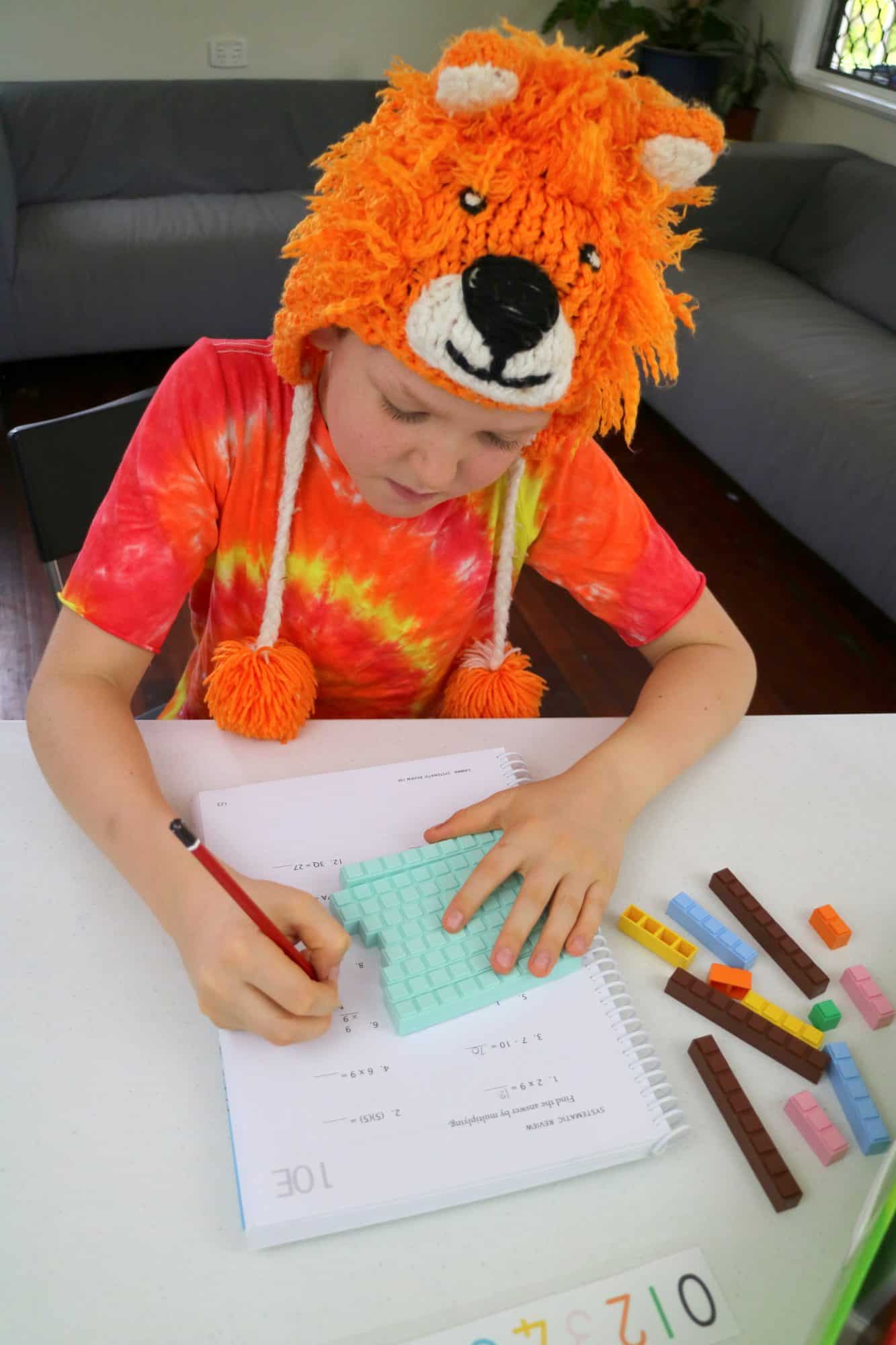
He’s finding it fairly easy, so it’s fun for him and building his confidence. But he’s also learning lots of little things he’d previously missed, and his mental maths is improving in leaps and bounds.
The other two kids are the same – they’re not being hugely challenged, but they’re solidifying their foundational skills. Plus they’re gaining the belief that they’re actually pretty good at maths, which will be a huge benefit to them when they get back to more difficult stuff.
Multi-Sensory Approach
You’ve seen the Math-U-See blocks, right? They’re pretty recognisable!

The blocks are a big part of the program because Math-U-See is multisensory, which means children use multiple senses and learning styles. This is great for layering learning and increasing effectiveness for all children – not just those who thrive on pen-and-paper work.
You’ll start with a box like the one above, but the manipulatives get more specific in later levels – there are two more sets.
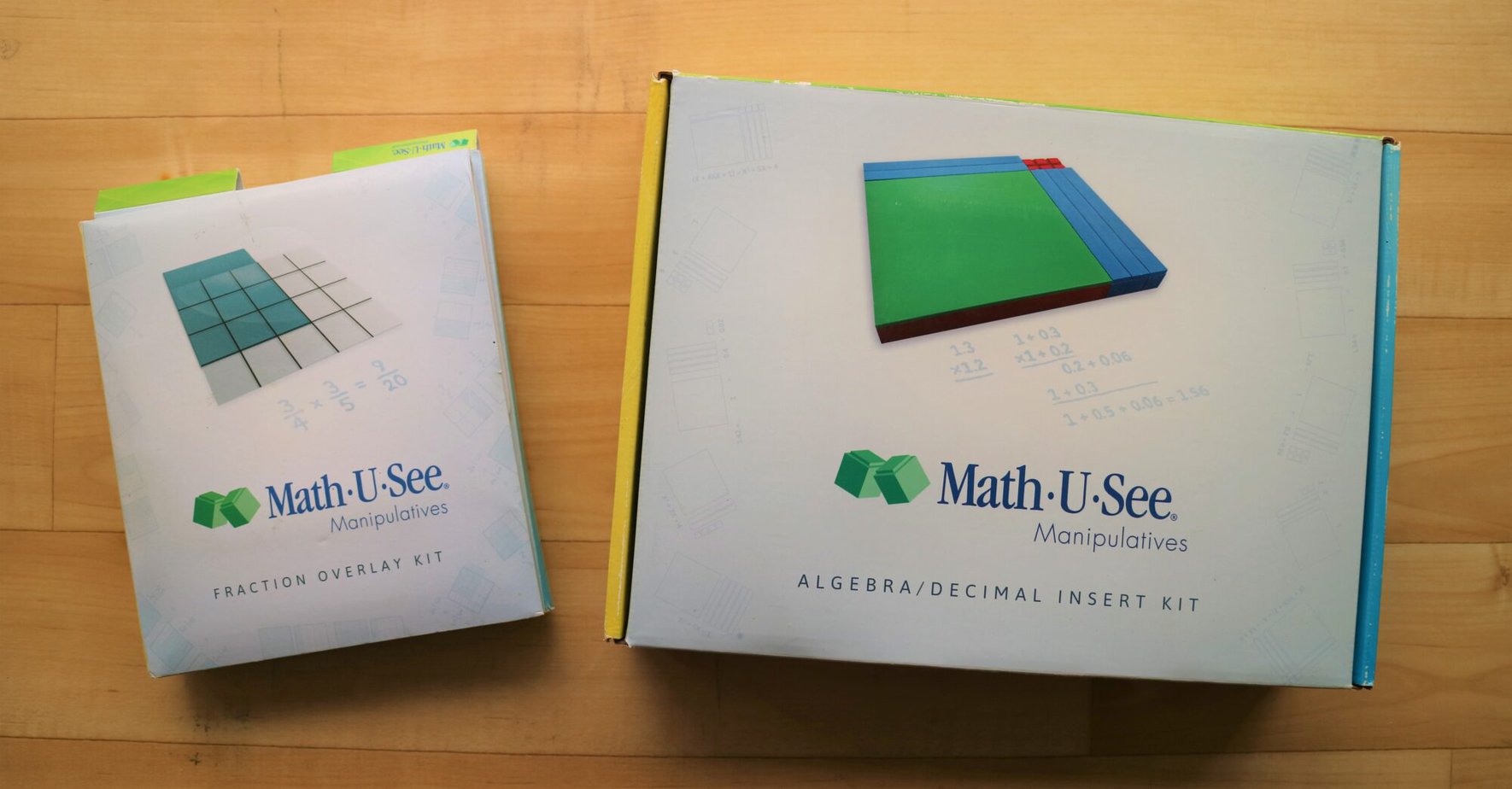
When you start Epsilon, you’ll add in fraction manipulatives. These are a fantastic quick and easy visual way to show how to find common denominators.
You simply make the fractions given in the sum, then add the opposite plastic overlay over the top.
In this example, you can see that 1/2 + 2/3 look like they can’t be combined by themselves.
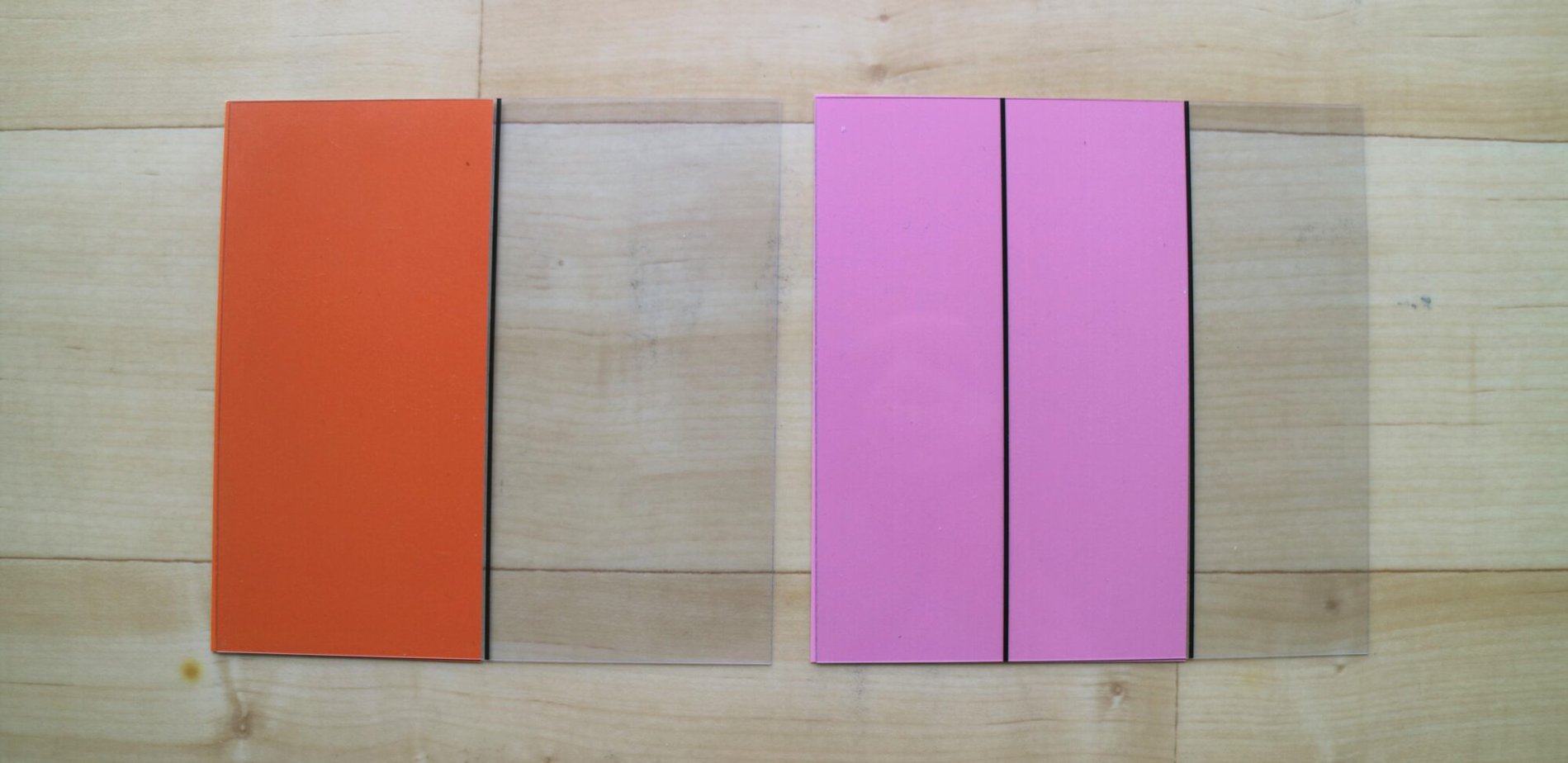
But by adding the complementary overlay, it’s immediately obvious that they can both be converted to sixths, and the new sum will be 3/6 + 4/6.

The algebra/decimals kit that begins with Zeta is the same.
Just like the integer block set, it gives a concrete representation of decimals and how each number relates to the whole – in this case, 1.24.
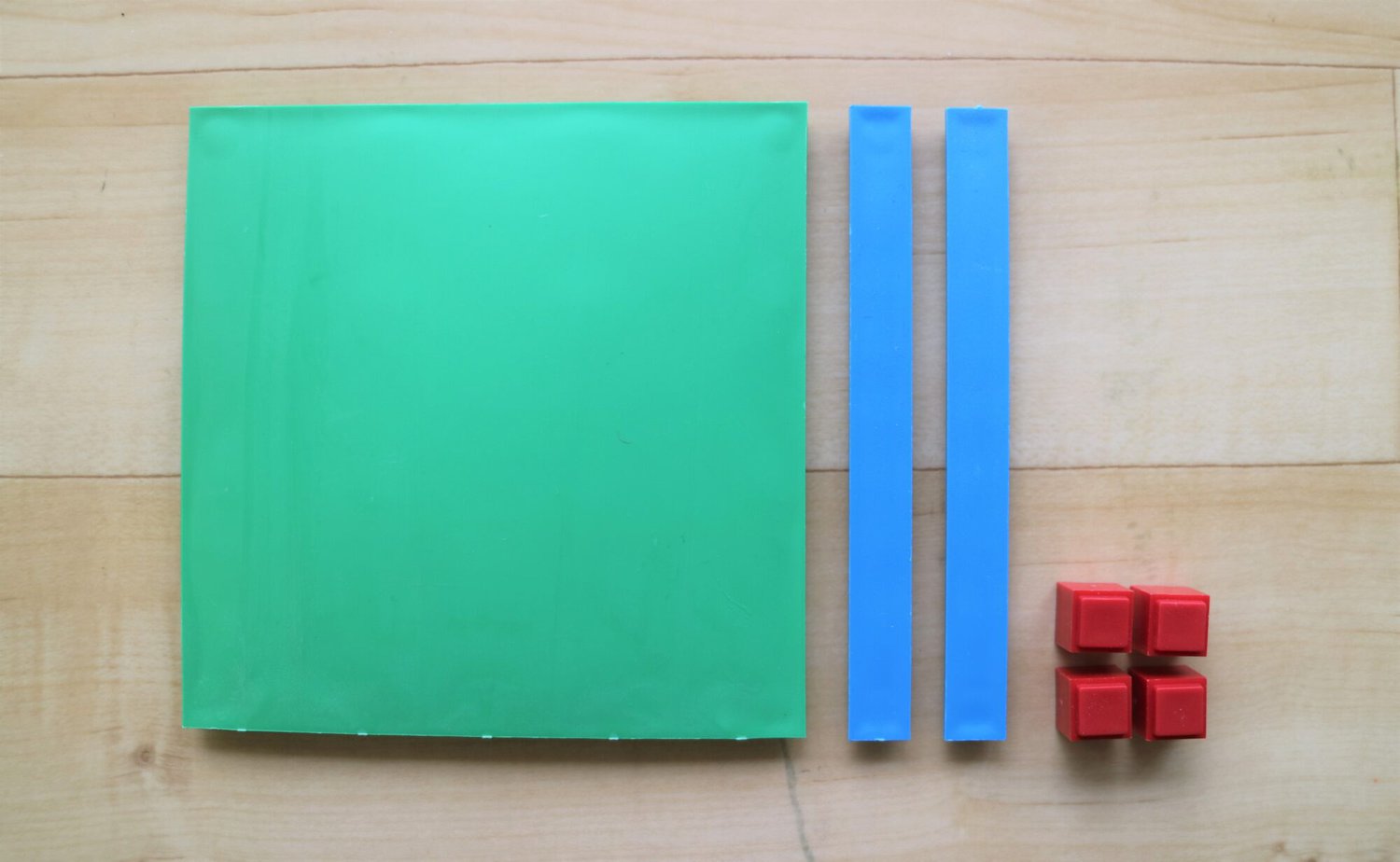
And when you progress to addition and other operations, each sum can be laid out visually – it makes it much easier to pick up misconceptions and errors in knowledge.
For example, this is 2.33 + 1.24. It’s immediately obvious how to combine the two numbers, and avoid the oh-so-common error of not being entirely sure where to put the decimal place!
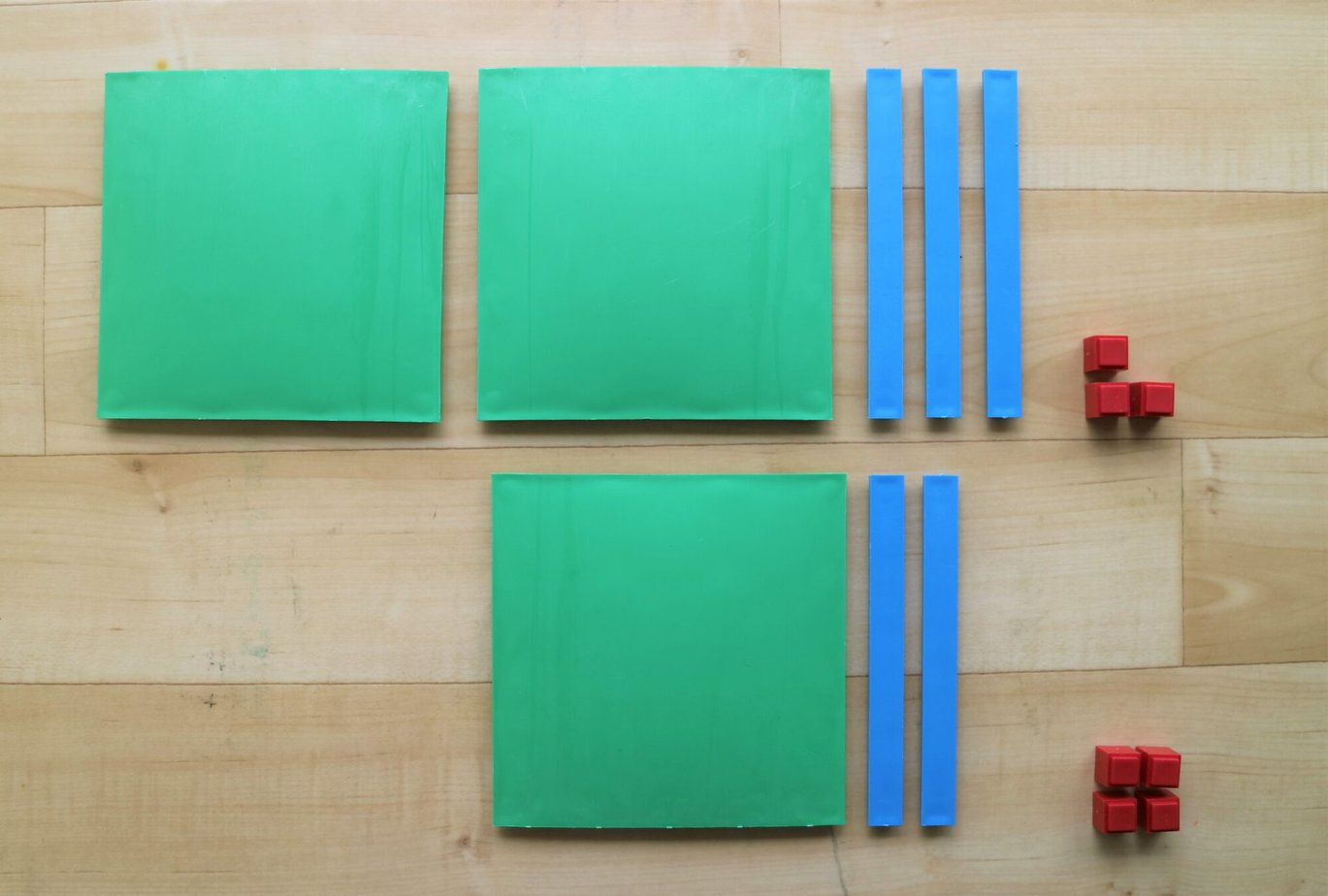
These are also used in algebra to represent unknowns, but we haven’t gotten that far yet.
Multisensory Learning – The Build-Write-Say Approach
This how it works in practice.
Build – Use the blocks to build a concrete, 3D example of the problem (kinesthetic, visual)
Write – Write down the steps and answers (reading/writing, visual)
Say – Talk about the problem and verbalize the answer while building and writing (auditory)

Like the number bookmarks? You can download your own for free at the end of this post!
Esther from Maths Australia explained this process and how effective it is really well in her 2019 Australian Homeschooling Summit workshop – watching this last year was what made me decide to use Math-U-See, I just had to get back to Australia to begin!
Overview of Math-U-See Levels
Math-U-See uses Greek letters to name its levels. So how does it all work with no grade or age levels? Here’s a quick overview of the primary levels.
Primer – introduction to maths
Alpha – single-digit addition and subtraction.
Beta – multi-digit addition and subtraction
Gamma – multiplication of single and multi-digit numbers
Delta – division of singles and multi-digit numbers
Epsilon – fractions and factors,
Zeta – decimals, percents, and conversions
Placement tests are online here. It’s important to follow the instructions – if your child struggles a little with a test, stop. Don’t think that because they can kind of do it they can go to the next level. We’re educating here, not just trying to keep up with arbitrary levels, and that means our kids need to know it well before progressing to more complex material.

Rex, for example, didn’t even do the first sum on the Alpha test. He looked at the first problem and said ‘Is that a plus sign?’ Then he started counting on his fingers to work it out (finger counting is a no-no), so I told him he’d failed miserably and would be starting with Alpha. He thought this was utterly hilarious.
He WAS doing Grade 4 workbooks………and was quite capable. So I wasn’t expecting him to start with Alpha, but now I’ve seen it in practice I’m so glad we did – he’s finally really understanding base 10 and becoming quite quick at mental addition.
Back to Math-U-See – For each level you get online videos, student book, teacher book and test book. The online videos are automatically added to your Member Dashboard but if you like, you can still purchase a DVD while stock lasts.
There’s also a songbook and audio – it has lots of catchy songs that include skip counting and other facts, plus colouring pages. We haven’t really used this, it’s a bit young for my kids, but I could see myself torturing them with it in the car if they were younger.
Running family joke there – When they were younger, I would regularly put on maths/grammar/science songs when I had a captive audience in the car. They’d all pretend to scream and block their ears, but they all knew the songs perfectly pretty quickly, and admit now that it was an easy way to learn!
Now they’re usually in charge of the music and know how to hijack Bluetooth if I try to take over. So my days of aural torture are over.
What does a lesson look like?
First up, we sit down together and watch the lesson online. They’re usually under five minutes, and explain the current work clearly, with examples and humour that the kids tend to enjoy.
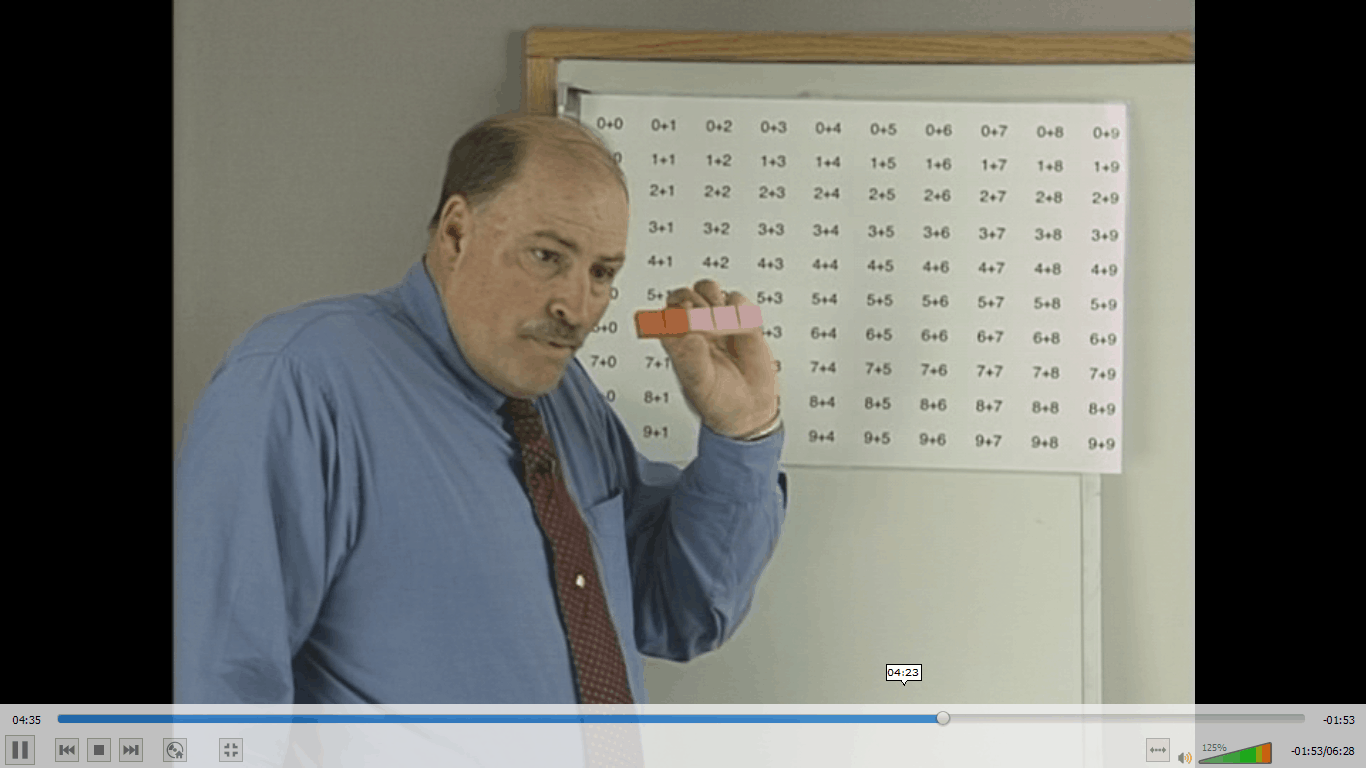
Then we do the work. The student book has six double-sided worksheets for each lesson. The first three worksheets, A-C, practice the new skill. The next three, D-F, mix the new skill with review.
Forrest and Holli tend to do the six worksheets in two sessions. Rex can usually manage two worksheets in a session. Once they get to the stage where they’re learning more difficult concepts I imagine they’ll need to spread them out a bit more – but for now they’re getting everything correct, so it’s fine.

When the six lessons are done they do the test. These are in the same format as the lessons, so there’s nothing tricky. We keep these pretty casual, and if they get a question incorrect I ask them to find where they went wrong (usually a simple matter of not paying full attention) and correct it. If they can correct it easily they get the mark – we’re testing for their benefit, not for arbitrary marks.
I record the date they do the lessons and the test results on the sheet at the front of the book, and we’re done. It’s pretty simple.
Maths Australia Membership Resources
Maths Australia have listened to parents and made all the Math-U-See DVD lessons available online!
This is such a huge bonus – I don’t know about you, but the right DVD was never in the drive or the right case. I could often waste ten minutes (or more) hunting the correct one down.
Now all I need to do is load the page, and we’re ready to start. It’s saving us SO much time.
There are other useful resources too – watch this video for a full overview of the membership contents.
Maths Teacher Training for Parents
Feel a bit nervous about teaching maths?
OK, most of us feel absolutely TERRIFIED about teaching maths!
It’s OK, Maths Australia has you covered. You can attend a 2-hour online workshop with Esther White (CEO and homeschooling mum of 5) and she’ll teach you how multi-sensory maths works, how to teach foundational concepts in a meaningful and effective way, and how to use the blocks with your children. The training especially focuses on intervention, special needs and students with learning differences – usually the parents who need it most.
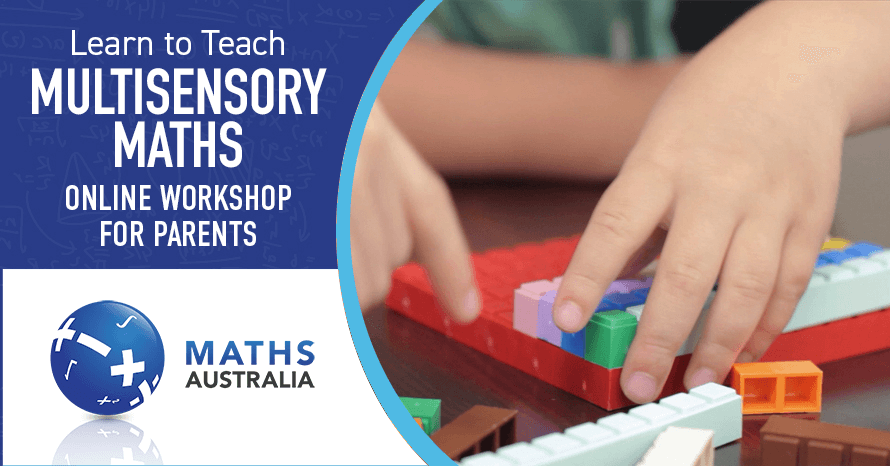
Best things about Math-U-See
The manipulatives! We’ve had some basic manipulatives before, but because I understand maths abstractly I just assumed my kids would too. Turns out they will – AFTER they understand it concretely.
I’ve been amazed at how useful the blocks are. With Rex in particular, I can actually see him making connections between the concrete blocks and the abstract concepts, and his understanding increases with every lesson.
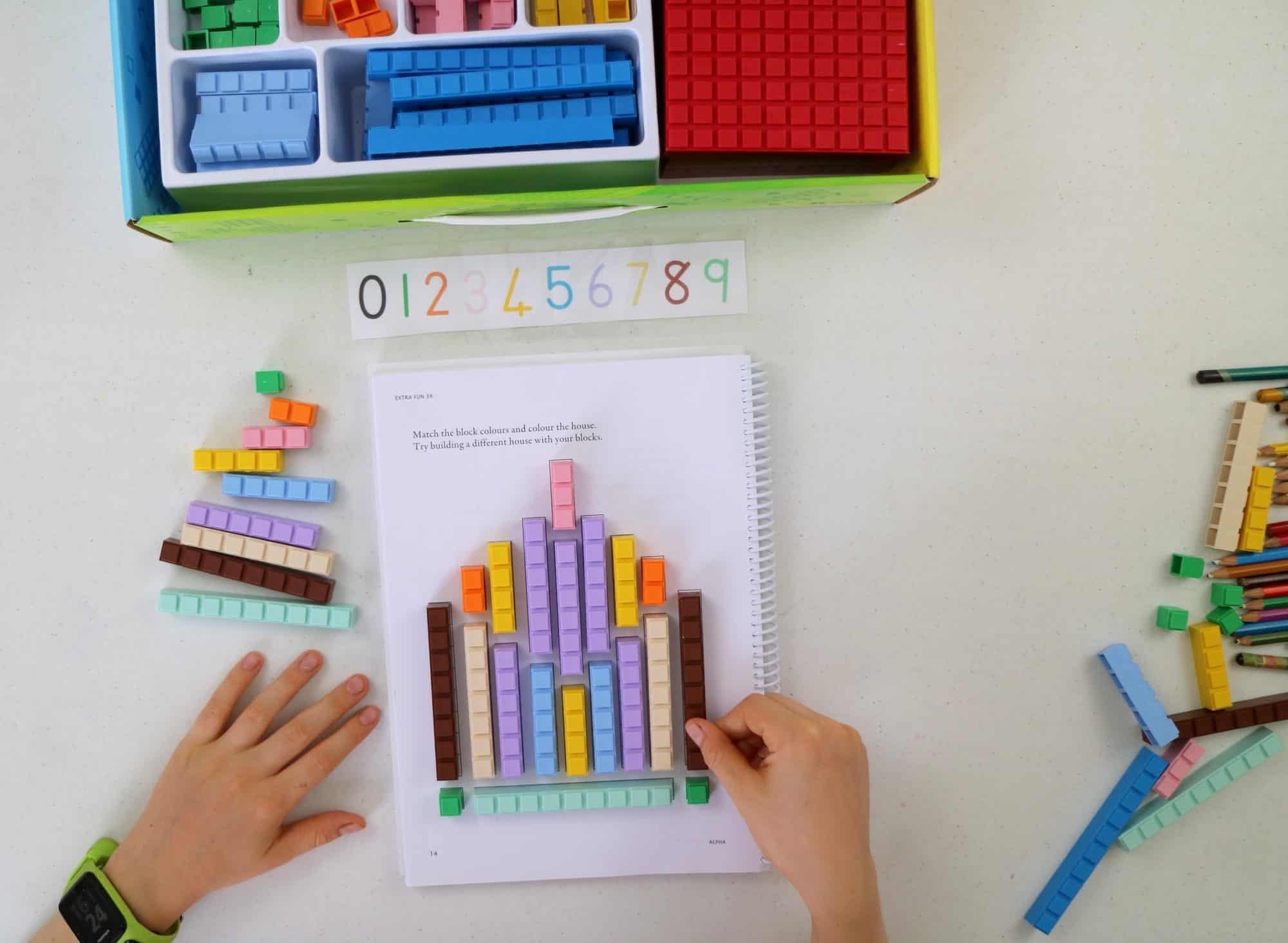
Short lessons – It’s much easier to sit down to a lesson knowing it will only take 15 minutes. And having that small win means my kids are much more likely to feel good and continue onto the next.
Mastery based – The school workbooks used to frustrate us. The kids would just begin to get the hang of a new concept, then the book would switch to another, not to return to the first until next year. Not great for deep understanding.
No annoying ‘fun’ stuff – I find that the further we get through homeschooling the more no-nonsense I like our resources to be – we want to get in, learn, and finish up without all the irritating clutter of characters and extraneous junk.
Word problems – Actual real-life situations! I find that our biggest problem, and most people’s, is being unable to work out what sum we need to do for real-life problems. So we might know that we need to work something out and have the ability to come up with the answer to the sum, but not know what sum we should do in the first place. The word problems are fantastic at helping us learn to apply the concepts to real life.

Experimenting with weight as spontaneous play
Not grade-specific – Ever tried to convince a child they need to do work below their actual grade or age level? It can be humiliating. Math-U-See is ordered by Greek letters and has no relation to grade levels. You can begin at any level without your child resisting the work or getting upset because they think they ‘should’ be further ahead.
Video lessons are FANTASTIC – I love not needing to explain things. The video lessons do all the explaining, quickly and clearly.
Negatives
Doesn’t match the Australian curriculum straight out-of-the-box – If you’re homeschooling for a short time or planning on going back to school Math-U-See might not suit. However, there are adaptations you can make to meet ACARA’s standards. If you’re swapping from another program or method, like we did, then you may have to start at a level earlier than you expected to fill in the gaps. But filling in the gaps is, well, great.

Every week is the same layout and routine – This could get monotonous for some. However, I really like it. I like knowing what to expect, and the kids don’t mind – it means they know what to expect and can just get it done.
Can get expensive – You may have a slight heart attack when you see your initial cost, it is more than doing the standard school workbooks. However, remember that it is actually a full program, not just a workbook, that you can reuse the blocks and teacher books for all children, and they have great resale value. I’ve noticed the Math-U-See stuff sells straight away online for a pretty good percentage of the initial cost.
Finally, in most lessons I have to remind them that the blocks aren’t Lego, that they’re for doing maths, not building towers halfway through. I’ve dealt with this by having block free play time after the work is done and I think it’s valuable time, because they make some pretty complicated patterns with the blocks and there would have to be connections happening upstairs about them.

This activity is actually in Alpha – build your own house. Rex prefers skyscrapers.
Should you try Math-U-See?
Yes – if you have a child with special needs who would benefit from the manipulatives. I’m really impressed at how much understanding Rex has shown with the simple examples of the blocks.
Yes – if you want REAL mastery of the basics, for your kids to have that now old-fashioned skill of quick and accurate mental maths and to really understand what they’re doing
Yes – if you’re not great at maths (or even if you are) and want something easy to deliver.
No – if you’re having a temporary break from school. It doesn’t align easily with the Australian Curriculum so moving into and out of school could be a problem. If you want to fill in gaps left from school programs and solidify concepts though, I think it would work really well.
No – if you prefer online programs or flashy, entertaining ones. This is hands-on and book-based and doesn’t waste time attempting to make it ‘fun’. Which is not to say parts of it aren’t enjoyable – there are lots of maths-based activities to do, but they’re not frivolous time-wasters.

How to start using Math-U-See
Think Math-U-See would suit your family? The first step is to head over and do the placement tests. These are all online, and will tell you exactly which level your child should start with.
Each level then has a complete set option. In Alpha, Beta, Gamma, and Delta, you get a set of Integer Blocks plus the student pack, teacher kit, and songbook. With Epsilon you’ll receive fraction overlays instead of blocks, and Zeta contains Integer Blocks and Algebra-Decimal inserts.
Have any more questions about Math-U-See? Ask in the comments and I’ll get back to you.
And did you like the look of the colour-coded number bookmarks in the pictures? Don’t forget to download your own Math-U-See bookmark! These have been so useful to us – they help to reinforce the block colours, but they also reduce number reversal to the point where it barely happens.


Great review Kelli! We have been using this program successfully for a few years now and I love the mastery approach and the simple no-distractions format. We used the placement test and it was spot on for my kids to review, consolidate then move forward. Sometimes we only do a couple of the worksheets for a lesson if it is very easy for them, more if they need practice.
Another feature I like is that measurement and geometry are taught sequentially alongside the appropriate number concepts, such as calculating area when you have learnt multiplication. And the Australian student books all use Aussie money and metric measurement.
I’m looking forward to my kids getting into the later levels; I might just get a grip on that high school maths at long last!
Hi. I love the review. It was perfect. I’m in the USA and would like to know how I could access the DVD’s online?
Hi Alicia,
Thank you! I’m not sure about the USA, you’d need to contact Math-U-See over there. The ones I reviewed were put up by Maths Australia and are for people who have bought the Australian version from them.
Kelly.